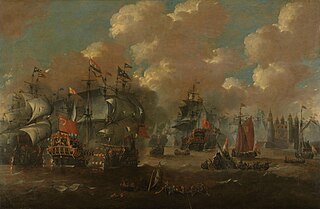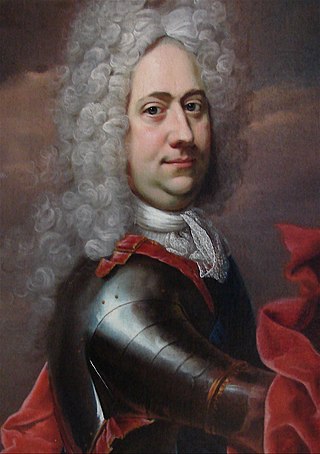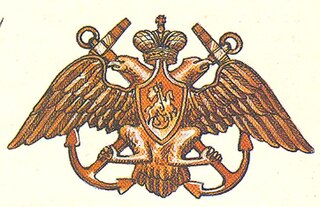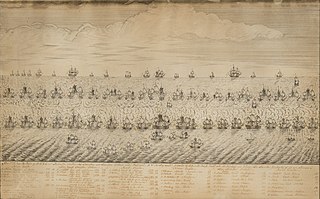
The Battle of Copenhagen of 1801, also known as the First Battle of Copenhagen to distinguish it from the Second Battle of Copenhagen in 1807, was a naval battle in which a British fleet fought and defeated a smaller force of the Dano-Norwegian Navy anchored near Copenhagen on 2 April 1801. The battle came about over British fears that the powerful Danish fleet would ally with France, and a breakdown in diplomatic communications on both sides.

A fire ship or fireship is a large wooden vessel set on fire to be used against enemy ships during a ramming attack or similar maneuver. Fireships were used to great effect against wooden ships throughout naval military history up until the advent of metal-hulled ships; they could also serve a considerable function in shock and awe strategies to harm the morale of enemy crews. Ships used for fireship tactics were sometimes surplus, obsolete or purpose-build vessels filled with gunpowder or other combustibles, but could also be improvised from active warships purposefully set on fire during engagements, such as if a vessel expended its munitions or had some other reason to be abandoned in battle.

The Russo-Swedish War of 1788–1790 was fought between Sweden and Russia from June 1788 to August 1790. The war was ended by the Treaty of Värälä on 14 August 1790 and took place concomitantly with both the Austro-Turkish War (1788–1791), Russo-Turkish War (1787–1792) and Theatre War. The war was, overall, mostly insignificant for the parties involved.

The Battle of Öland was a naval battle between an allied Danish-Dutch fleet and the Swedish navy in the Baltic Sea, off the east coast of Öland on 1 June 1676. The battle was a part of the Scanian War (1675–79) fought for supremacy over the southern Baltic. Sweden was in urgent need of reinforcements for its north German possessions; Denmark sought to ferry an army to Scania in southern Sweden to open a front on Swedish soil.

The Battle of Møn, also known as the Battle of Fehmarn, took place 31 May–1 June 1677, as part of the Scanian War. A smaller Swedish squadron under Admiral Erik Sjöblad attempted to sail from Gothenburg to join the main Swedish fleet in the Baltic Sea. It was intercepted by a superior Danish-Norwegian force under Niels Juel and decimated over the course of two days. The Swedes lost 8 ships and over 1,500 men dead, injured or captured, including Admiral Sjöblad himself, while the Danish losses were insignificant.

The Prussian Navy, officially the Royal Prussian Navy, was the naval force of the Kingdom of Prussia from 1701 to 1867.

The naval Battle of Dynekilen took place on 8 July 1716 during the Great Northern War between a Dano-Norwegian fleet under Peter Tordenskjold and a Swedish fleet under Olof Strömstierna. The battle resulted in a Dano-Norwegian victory.

The Battle of the Sound was a naval engagement which took place on 8 November 1658 during the Second Northern War, near the Sound or Øresund, just north of the Danish capital, Copenhagen. Sweden had invaded Denmark and an army under Charles X of Sweden had Copenhagen itself under siege. The Dutch fleet was sent to prevent Sweden from gaining control of both sides of the Sound and thereby controlling access to the Baltic Sea as well as of its trade.

Niels Juel was a Danish admiral and naval hero. He served as supreme command of the Dano-Norwegian Navy during the late 17th century and oversaw development of the Danish-Norwegian Navy.

Ulrik Christian Gyldenløve, Count of Samsø was a Danish Admiral in the Royal Danish-Norwegian Navy and Governor of Iceland. He was an acknowledged illegitimate son of King Christian V of Denmark and his officially acknowledged royal mistress Sophie Amalie Moth.

The Imperial Russian Navy operated as the navy of the Russian Tsardom and later the Russian Empire from 1696 to 1917. Formally established in 1696, it lasted until dissolved in the wake of the February Revolution of 1917. It developed from a smaller force that had existed prior to Tsar Peter the Great's founding of the modern Russian navy during the Second Azov campaign in 1696. It expanded in the second half of the 18th century and reached its peak strength by the early part of the 19th century, behind only the British and French fleets in terms of size.

Kronan, also called Stora Kronan, was a Swedish warship that served as the flagship of the Swedish Navy in the Baltic Sea in the 1670s. When built, she was one of the largest seagoing vessels in the world. The construction of Kronan lasted from 1668 to 1672 and was delayed by difficulties with financing and conflicts between the shipwright Francis Sheldon and the Swedish admiralty. After four years of service, the ship foundered in rough weather at the Battle of Öland on 1 June 1676: while making a sharp turn under too much sail she capsized, and the gunpowder magazine ignited and blew off most of the bow. Kronan sank quickly, taking about 800 men and more than 100 guns with her, along with valuable military equipment, weapons, personal items, and large quantities of silver and gold coins.

The Battle of Køge Bay was a naval battle between Denmark-Norway and Sweden that took place in the bay off of Køge 1–2 July 1677 during the Scanian War. The battle was a major success for Admiral Niels Juel and is regarded as the greatest naval victory in Danish naval history.

The battle of Bornholm was a naval battle between a superior Swedish and a smaller Danish-Dutch fleet that was fought 25–26 May 1676 as a part of the Scanian War. The objective for both sides was naval supremacy in the southern Baltic Sea. The Swedish commander Lorentz Creutz sought to destroy the allied fleet and then land reinforcements in Swedish Pomerania to relieve the Swedish forces in northern Germany. The aim of the Danish fleet under Niels Juel was to prevent this reinforcement without being destroyed by the superior numbers of the Swedish forces.

The Dano-Swedish War of 1658–1660 was a war between Denmark–Norway and Sweden, with the former backed by the Dutch Republic and Poland. It is known in Denmark as the Second Karl Gustav War, in Norway as Bjelkes Feud in Sweden as Karl Gustav's Second Danish War, and in the Netherlands as the Swedish-Dutch War.

The English Wars were a series of conflicts pitting the United Kingdom and Sweden against Denmark-Norway as part of the Napoleonic Wars. It is named after England, the common name in Scandinavia for the United Kingdom, which declared war on Denmark-Norway due to disagreements over the neutrality of Danish trade and to prevent the Danish fleet falling into the hands of the First French Empire. It began with the Battle of Copenhagen (1801) and its latter stage from 1807 onwards was followed by the Gunboat War, the Dano-Swedish War of 1808–09 and the Swedish invasion of Holstein in 1814.
The Battle of Ebeltoft was a naval battle between a Swedish and a Danish/Dutch fleet, during the Dano-Swedish War of 1658 to 1660. The allied fleet was ordered to secure a troop transport fleet to the Swedish-controlled island Fyn. Eight Swedish frigates under the command of Owen Coxe attacked the fleet and took the allies by surprise. After a long fight one Dutch ship exploded, the rest of the Danish/Dutch ships were captured and the transport fleet was destroyed. The Danish captain was badly wounded and died during the battle. After the battle, Owen Coxe was ennobled under the name Siölöw.

Battle of Rügen was a major naval battle fought on August 8, 1715 off Jasmund on the Swedish island of Rügen during the Great Northern War.
Maerten Thijssen, died 1657, was a Dutch admiral who entered into Swedish service, becoming a Swedish admiral and a Swedish nobleman under the name Mårten Anckarhielm. He played an important role at the Battle of Fehmarn 1644.

The British Baltic Fleet and also known as the Baltic Squadron was a series of temporary or semi permanent fleets of the Royal Navy. They were assembled at Spithead a naval anchorage in the English Channel for various naval operations in the Baltic Sea from 1658 to 1856 commanded by the Commander-in-Chief, Baltic Fleet.


















